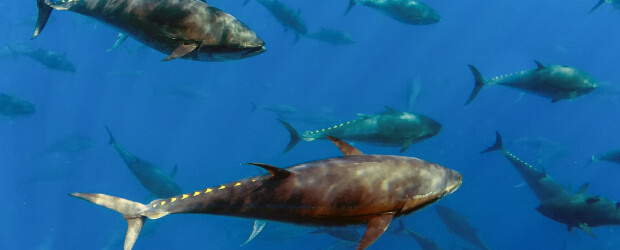As top predators with few natural enemies, bluefin tuna once enjoyed long lifespans in thriving oceans. However, over the past 80 years, overfishing led to an estimated 80% to 90% population reduction.1 Consumers seek out this highly prized delicacy in the form of sushi and sashimi, resulting in enormous payouts for tuna fisheries, with a single bluefin tuna selling for over three million dollars.2
Although various countries and agencies continue to advocate for better policies, all three bluefin tuna species remain on the International Union for Conservation of Nature (IUCN) Red List.3 In this post, we’ll answer the question of “is tuna an endangered species” while exploring the history of bluefin tuna and the actions taken to preserve the species.
The Importance of Bluefin Tuna In the Marine Ecosystem
Bluefin are magnificent creatures, ranging from six to 10 feet and up to 1,500 pounds, making them the largest tunas and a predator topped only by great white sharks. As warm-blooded apex predators with sharp vision, bluefin tuna swim in schools to hunt and eat protein-rich marine life, such as mackerel, sardine, herring and eels.
The three bluefin species cover great distances during their lives:4
- Southern bluefin tuna (Thunnus maccoyii) spawn in the Indian Ocean and travel the Pacific, Atlantic and Indian oceans.
- Atlantic bluefin tuna (Thunnus thynnus) live in eastern and western waters, spawn in the Gulf of Mexico or the Mediterranean ocean and travel the Atlantic.
- Pacific bluefin tuna (Thunnus orientalis) spawn in the Sea of Japan and the northwestern Philippine Sea. They travel the Pacific Ocean for more than 5,000 miles to the California coast.
Depending on the location, bluefin tuna doesn’t mature and reproduce until age four to eight years. They can live to age 40 or 50. However, the bluefin tuna’s slow growth combined with voracious human appetites for sushi makes bluefin tuna vulnerable to human predators.
With ongoing exploitation and the capture of young bluefin tuna, the marine ecosystem also is threatened. The loss of the species may increase benthopelagic cephalopods, such as octopuses, squids and cuttlefishes. This change affects the sardine population and disrupts the ecological balance.
Is Tuna an Endangered Species?
The IUCN lists 63 tuna species, and 15 are decreasing in population.5 Of these, the Southern bluefin tuna are at most risk and considered critically endangered (CR). However, the Atlantic bluefin tuna are endangered, while the Pacific bluefin tuna are vulnerable.
In March 2020, the International Seafood Sustainability Foundation’s Status of the World Fisheries for Tuna noted that Pacific and southern bluefin stocks were overfished, with populations dropping below-recommended levels.6 Furthermore, the International Commission for the Conservation of Atlantic Tunas (ICCAT) reported in September 2020 that West Atlantic bluefin declined at higher than expected rates, from an estimated 7.5% between 2017 to 2020 to an 11.7% decline.7
With high-demand—and high prices—for bluefin tuna, overfishing continues to be problematic. It’s a situation that’s been reported in the news for more than a decade. Although there’s been some progress, it often follows the old cliché of two steps forward followed by two steps backward.
Bluefin Tuna: Endangered and Vulnerable
Bluefin tuna demand isn’t decreasing as The Pew Charitable Trusts found, “The combined catch tonnage of all bluefin species rose 73% from 2012 to 2018—totaling 67,647 metric tons in 2018.”8 Moreover, in 2020, at the first Tokyo auction, a 608-pound “bluefin tuna sold for 193.2 million yen ($1.8 million),” according to Reuters.9
The same buyer purchased a 612-pound bluefin tuna for $3.1 million in 2019, making the 2020 purchase the second largest on record. 2 Although high prices encourage fishers to skirt regulations, the problem also stems from the cost of capturing larger tuna.9
The Pew Charitable Trusts remarks, "A bigger catch does not always translate into more revenue. And when factoring in the costs associated with higher catches, profits may even decline.”8 Younger, lighter tuna can deliver a higher profit yet remove valuable tuna before they can reproduce, creating an unsustainable cycle.
Unfortunately, a lack of data and political will combined with a desire for short-term economic gains presents an ongoing problem.
National and International Issues Compound the Problem
In 2017, ICCAT said Western Atlantic bluefin tuna stock was above the threshold and not overfished but cautioned managers against raising the fishing quotas.10 Yet, restrictions put in place by the Obama administration to protect the Western Atlantic bluefin spawning area were quickly cut, as were the National Oceanic and Atmospheric Administration’s longline gear restrictions imposed in 2015.
Although the National Marine Fisheries initially proposed listing species, like the Pacific bluefin tuna, to a threatened or endangered species under the Endangered Species Act (ESA) in 2016, the Trump administration declined to do so in 2017.11
Furthermore, National Oceanic and Atmospheric Administration (NOAA) Fisheries aimed to increase swordfish catches in 2020 by opening “three areas previously restricted during parts of the year.”12 The agency believed bluefin tuna would still be protected by only allowing “pelagic longline fishermen to set out on trips if they stay within their individual share of the United States bluefin quota.”
This combination of political shortfalls increased the use of longline vessels during peak spawning times while opening the door to claims of accidental bycatches, which are bluefin tuna caught unintentionally.
A Need for a Multi-Layered and Consistent Approach
The endangerment of bluefin tuna is an ecological and financial concern spanning many oceans and countries. Leaders must take action to support long-term economic security using a science-based management approach to manage fish catches and collect data.
There are many methods to increase the biomass of bluefin tuna used by regional and international agencies worldwide. However, switching policies can quickly remove all gains. Therefore, experts recommend using a systematic process that includes:
- The use of computer modeling to create specific goals.
- Development of science-based harvest strategies.
- Mandates for electronic monitoring systems on longline vessels.
- Improving international and regional management of fisheries.
The United Nations’ Sustainable Development Goals stipulates that companies should and must be key players in the journey toward sustainable development. And many businesses understand that promoting and enacting sustainable practices is a profitable endeavor.1 However, to gain true headway, the planet needs more professionals with environmental law backgrounds who are willing and able to draft mandates and laws that will truly preserve biodiversity.
Support Marine Diversity and Protect Endangered Bluefin Tuna
Although the plight of bluefin tuna is uncertain, it’s only one example of how multiple industries and agencies must collaborate with environmental groups to find truly sustainable solutions. If you’d like to help conserve biodiversity and create sustainable practices, consider an online Masters of Jurisprudence in Environmental Law from Tulane University Law School. With your degree, you can help drive change and accomplish this goal.
- Retrieved on March 17, 2021, from eli.org/vibrant-environment-blog/bluefin-tuna-critically-endangered-species-or-%E2%80%9Cworld-gourmet%E2%80%9D
- Retrieved on March 17, 2021, from ktla.com/news/nationworld/612-pound-tuna-fetches-3-1-million-at-auction-in-japan/
- Retrieved on March 17, 2021, from iss-foundation.org/understanding-the-iucn-redlist/
- Retrieved on March 17, 2021, from worldwildlife.org/species/bluefin-tuna#:~:text=Bluefin%20are%20the%20largest%20tunas,set%20flush%20to%20their%20body
- Retrieved on March 17, 2021, from iucnredlist.org/search?query=tuna&searchType=species
- Retrieved on March 17, 2021, from iss-foundation.org/downloads/20140/
- Retrieved on March 17, 2021, from iccat.int/Documents/SCRS/SCRS_2020_Advice_ENG.pdf
- Retrieved on March 17, 2021, from pewtrusts.org/en/research-and-analysis/reports/2020/10/netting-billions-2020-a-global-tuna-valuation
- Retrieved on March 17, 2021, from reuters.com/article/us-new-year-japan-tuna-auction/tuna-sells-for-1-8-million-in-first-tokyo-auction-of-2020-second-highest-ever-idUSKBN1Z4060
- Retrieved on March 17, 2021, from iccat.int/Documents/Meetings/Docs/2017_SCRS_REP_ENG.pdf
- Retrieved on March 17, 2021, from federalregister.gov/documents/2017/08/08/2017-16668/listing-endangered-and-threatened-wildlife-and-plants-notice-of-12-month-finding-on-a-petition-to
- Retrieved on March 17, 2021, from fisheries.noaa.gov/feature-story/new-requirements-protect-bluefin-tuna-expand-opportunities-other-fisheries


